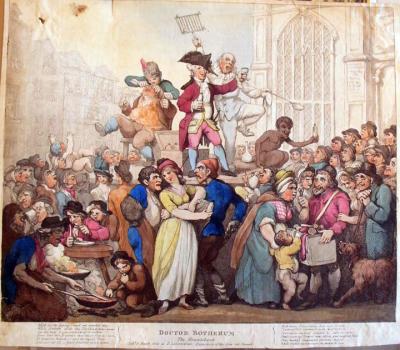Thomas Rowlandson (1756-1827), Doctor Botherum, the Mountebank, 1800. Etching with hand coloring. Graphic Arts, British caricatures, drawer 5
Joseph Grego (1843-1908), Rowlandson the Caricaturist (London: Chatto and Windus, 1880). Graphic Arts Collection (GARF)
In Joseph Grego’s narrative-style catalogue raisonné of Thomas Rowlandson’s prints (volume 2, p. 3), he speculates,
from the bustle and life visible on all sides it would seem that the period is fair time, when the rustics and agricultural population of the vicinity in general flock into the town, holiday-making. A travelling mountebank has established his theatre in the market-place; … while his attendants, Merry Andrew and Jack Pudding, are going through their share of the performance … The rural audience is solidly contemplating the antics of the party, without being particularly moved by Dr. Botherum’s imposing eloquence, these vagabond scamps being frequently clever rogues, blessed with an inexhaustible fund of bewildering oratory, and witty repartee at glib command.
Throughout the crowd, Rowlandson offers other forms of quackery and charlatans, with almost everyone either deceiving or being deceived.
Grego then speculates that Dr. Botherum is a caricature of Dr. Bossy (or Boosy or Bosey), a celebrated German mountebank, who practiced theatrical acts of healing in London. Bossy was said to have been the last of the respectable charlatans. He set up his small stage alternately in Covent Garden market and at Tower Hill, arriving to both in a chariot wearing colorful clothes. Bosey attracted large crowds for awhile but as he grew older, his audiences grew smaller and he ended his days selling potions and pills in the open-air markets of Yorkshire.
See also Leslie G. Mathews, “Licensed Mountebanks in Britain,” Journal of the History of Medicine and Allied Sciences 19, no. 1 (1964): 30-45.
